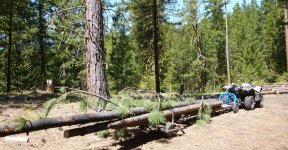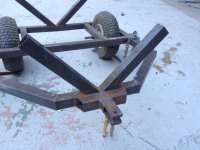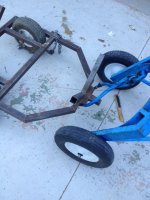Sodo
Elite Member
- Joined
- Apr 21, 2012
- Messages
- 3,197
- Location
- Cascade Mtns of WA state
- Tractor
- Kubota B-series & Mini Excavator
I'm showing this as an example of a simple project that can be done well within the capacity of a 120v MIG. The welder was a Miller 135, which is rated to weld steel up to 3/16" thickness. You will see that some 3/8" steel was also welded on this project (with the 120v machine). This project was done 4 years ago and nothing broke, even though it was hastily constructed.

I had to remove a bunch of small 6" or less trees that were obstructing the view. And for forest-fire safety, called "fuels reduction". The trees were tall and skinny, and bunched close together, on a steep hillside. My plan was to drag them up the hill with a 4WD ATV, and away to a pile. Very quickly, I found that the ATV could only pull one log at a time up the steep hill dragging on the ground. To speed up this job (pull multiple trees) they needed to be on wheels.
Off to the shop to build a lightweight dolly. It's made of 1 1/2" square thinwall steel tube. Dimension is .065 wall (also known as 16ga), or 1/16th inch, this is thin, and is on the edge of too thin, it takes a bif of technique to not burn holes with the 120v machine. To weld this with stick (and 3/32" rod) would require a fairly high level of skill, but a MIG can do .065 nicely with a lower level of skill. I was concerned that the thin-wall material was too lightweight for the job, but carrying it up and down the steep hillside, lightweight increase the amount of work that the people can do. Luckily it survived without ever breaking.
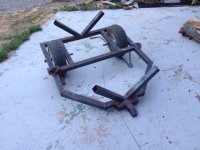
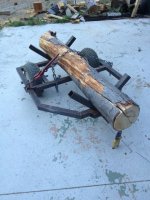
The clevis hitch is 3/8" steel, welded with the 120v machine. While the 3/8" is clearly beyond the welder's capacity, I had no trouble with it due to the bracing plates on the side. I could have preheated it before welding but chose to brace it which was much faster and more efficient than the preheat process. By a later change of design (using the tongs) this 3/8" clevis is no longer used and could be cut off.
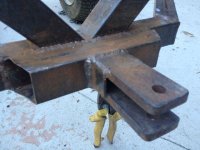
Here's a 1/4" bolt for scale.
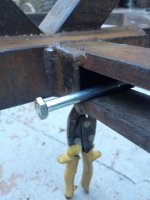
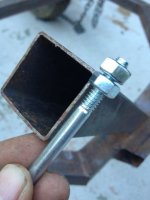
One weld I thought might be at its limit was the one between the "V". I kept thinking I should have braced it with a vertical on each side (in compression, down to the frame), but had no problem. I actually left it un-braced, kind of like a "fuse" to tell me the strength necessary. But this thing was so far overloaded, so many times constructed as shown that I stopped worrying.
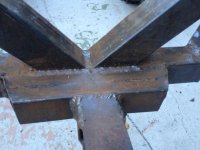
There was one iteration on this project. We had hired help for this job, and to keep everyone productive I had to reduce the deadhead time. I found that I wanted to haul the dolly back to the hillside with the Log arch (the blue device), so I cut the frame corners at 45 degrees, and added a way that the log arch "tongs" could attach quickly to the log dolly for the return (empty) trip.
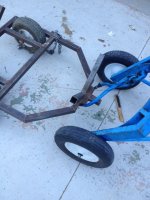
I had to remove a bunch of small 6" or less trees that were obstructing the view. And for forest-fire safety, called "fuels reduction". The trees were tall and skinny, and bunched close together, on a steep hillside. My plan was to drag them up the hill with a 4WD ATV, and away to a pile. Very quickly, I found that the ATV could only pull one log at a time up the steep hill dragging on the ground. To speed up this job (pull multiple trees) they needed to be on wheels.
Off to the shop to build a lightweight dolly. It's made of 1 1/2" square thinwall steel tube. Dimension is .065 wall (also known as 16ga), or 1/16th inch, this is thin, and is on the edge of too thin, it takes a bif of technique to not burn holes with the 120v machine. To weld this with stick (and 3/32" rod) would require a fairly high level of skill, but a MIG can do .065 nicely with a lower level of skill. I was concerned that the thin-wall material was too lightweight for the job, but carrying it up and down the steep hillside, lightweight increase the amount of work that the people can do. Luckily it survived without ever breaking.


The clevis hitch is 3/8" steel, welded with the 120v machine. While the 3/8" is clearly beyond the welder's capacity, I had no trouble with it due to the bracing plates on the side. I could have preheated it before welding but chose to brace it which was much faster and more efficient than the preheat process. By a later change of design (using the tongs) this 3/8" clevis is no longer used and could be cut off.

Here's a 1/4" bolt for scale.


One weld I thought might be at its limit was the one between the "V". I kept thinking I should have braced it with a vertical on each side (in compression, down to the frame), but had no problem. I actually left it un-braced, kind of like a "fuse" to tell me the strength necessary. But this thing was so far overloaded, so many times constructed as shown that I stopped worrying.

There was one iteration on this project. We had hired help for this job, and to keep everyone productive I had to reduce the deadhead time. I found that I wanted to haul the dolly back to the hillside with the Log arch (the blue device), so I cut the frame corners at 45 degrees, and added a way that the log arch "tongs" could attach quickly to the log dolly for the return (empty) trip.

Attachments
Last edited:
